MGMT6003 Operations Management: Vinci's Cafe Analysis and Plan
VerifiedAdded on 2023/06/10
|16
|4367
|138
Report
AI Summary
This report presents a comprehensive analysis of Vinci's Cafe's operations management. It begins with an introduction to operations management, defining its core functions and importance in businesses. The report then outlines the creation of an operational plan and a process map specifically tailored for Vinci's Cafe, a coffee shop located in New South Wales, Australia. It identifies the critical components of the cafe's operations management, such as product selection, conversion systems, plant layout, production planning, and quality assurance, demonstrating their relationship to decision-making and the value chain. Furthermore, the report evaluates and applies principles and quantitative methodologies, including optimization modeling, linear programming, scenario modeling, and data mining, to assist in decision-making processes related to operations process planning, scheduling, and inventory management. The report also examines the role of operations management in the strategic management of organizations, including supply chain considerations. Finally, the report concludes with a summary of the findings and insights regarding the effective management of Vinci's Cafe.
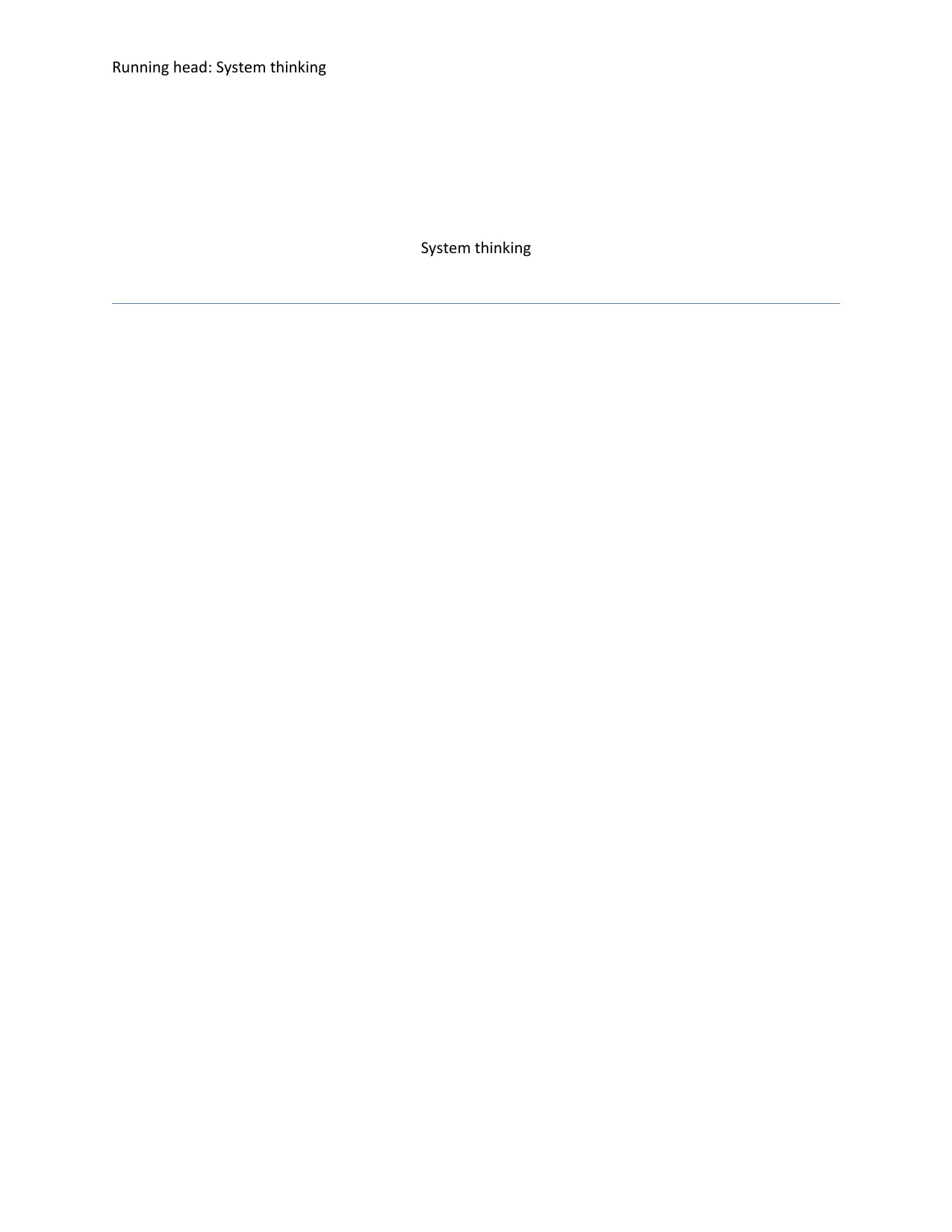
Running head: System thinking
System thinking
System thinking
Paraphrase This Document
Need a fresh take? Get an instant paraphrase of this document with our AI Paraphraser
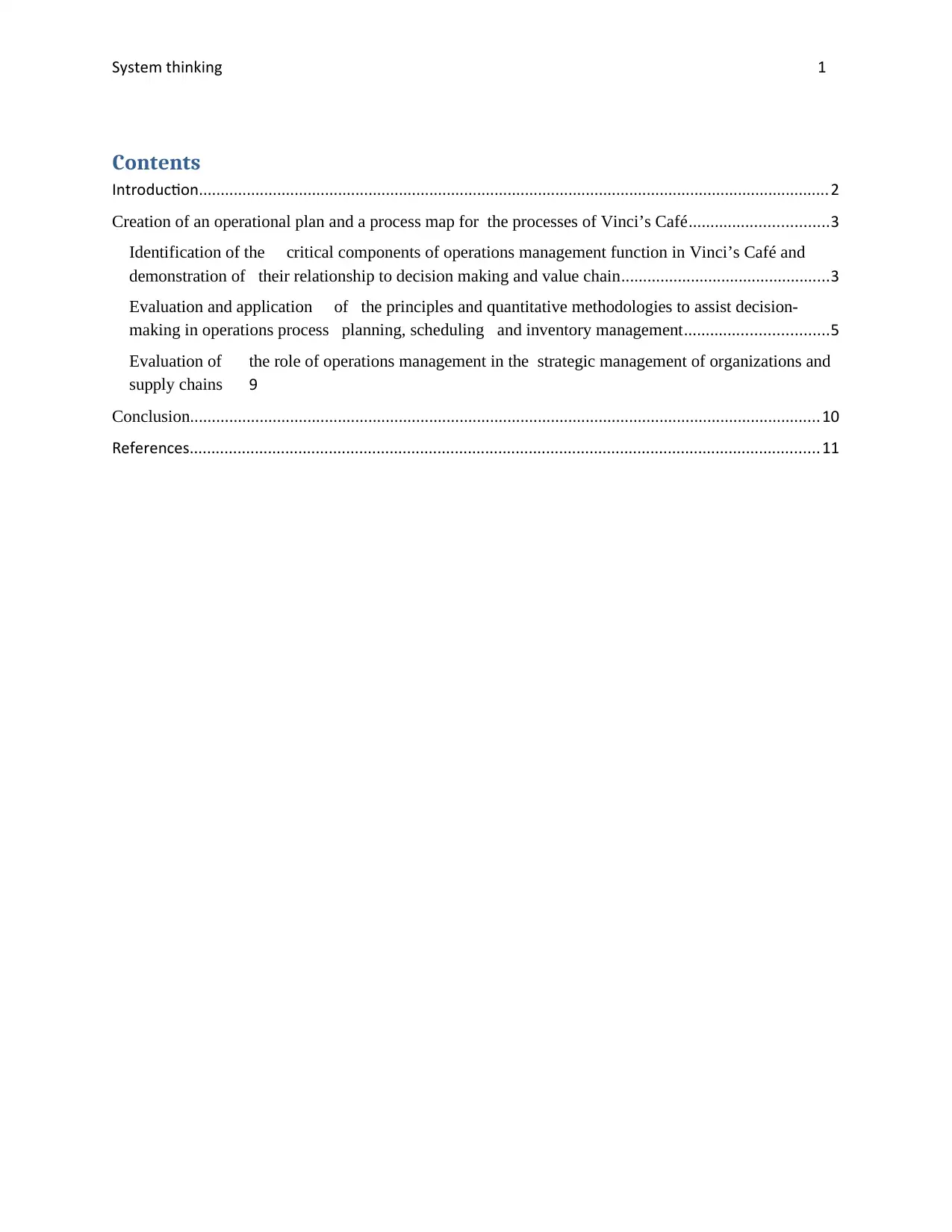
System thinking 1
Contents
Introduction.................................................................................................................................................2
Creation of an operational plan and a process map for the processes of Vinci’s Café................................3
Identification of the critical components of operations management function in Vinci’s Café and
demonstration of their relationship to decision making and value chain................................................3
Evaluation and application of the principles and quantitative methodologies to assist decision-
making in operations process planning, scheduling and inventory management.................................5
Evaluation of the role of operations management in the strategic management of organizations and
supply chains 9
Conclusion.................................................................................................................................................10
References.................................................................................................................................................11
Contents
Introduction.................................................................................................................................................2
Creation of an operational plan and a process map for the processes of Vinci’s Café................................3
Identification of the critical components of operations management function in Vinci’s Café and
demonstration of their relationship to decision making and value chain................................................3
Evaluation and application of the principles and quantitative methodologies to assist decision-
making in operations process planning, scheduling and inventory management.................................5
Evaluation of the role of operations management in the strategic management of organizations and
supply chains 9
Conclusion.................................................................................................................................................10
References.................................................................................................................................................11
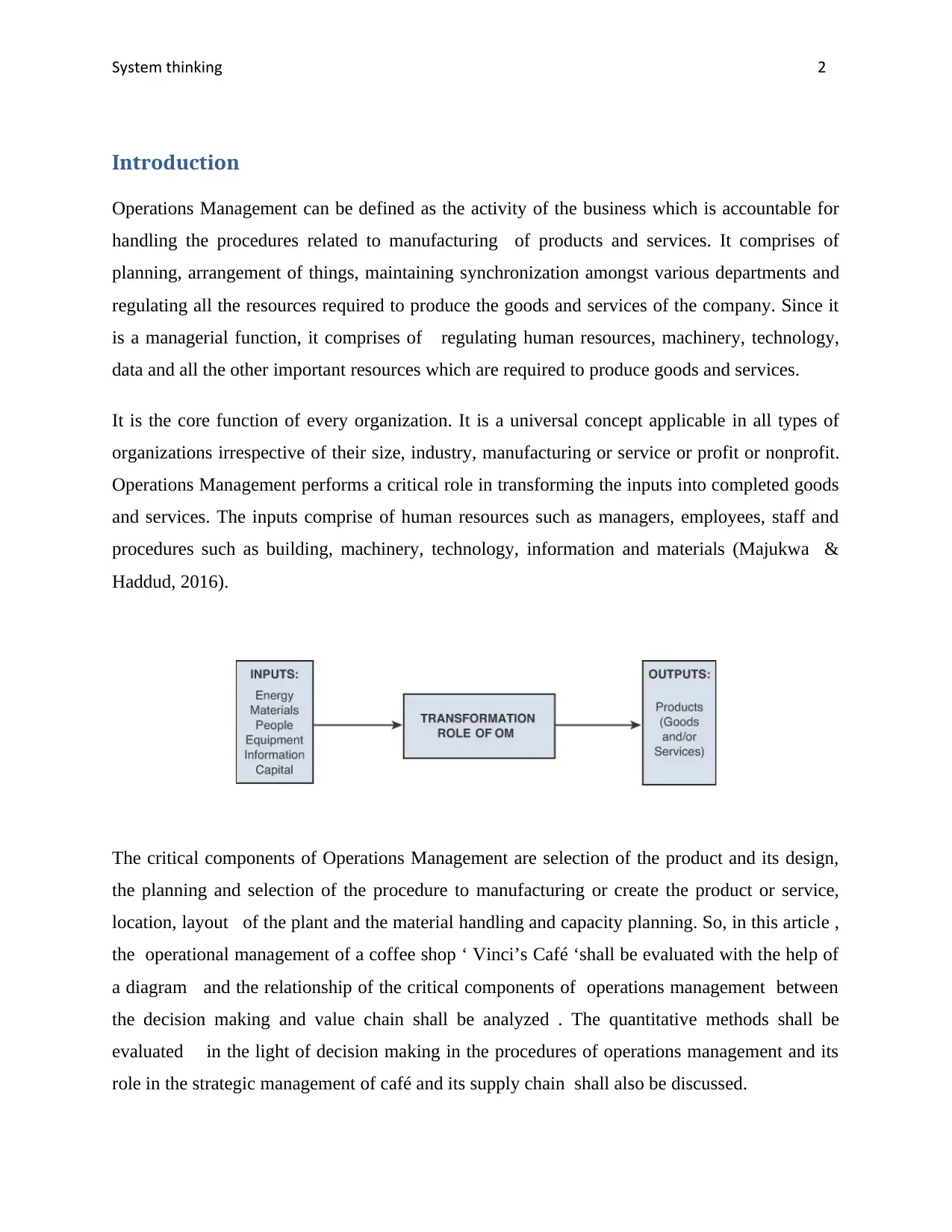
System thinking 2
Introduction
Operations Management can be defined as the activity of the business which is accountable for
handling the procedures related to manufacturing of products and services. It comprises of
planning, arrangement of things, maintaining synchronization amongst various departments and
regulating all the resources required to produce the goods and services of the company. Since it
is a managerial function, it comprises of regulating human resources, machinery, technology,
data and all the other important resources which are required to produce goods and services.
It is the core function of every organization. It is a universal concept applicable in all types of
organizations irrespective of their size, industry, manufacturing or service or profit or nonprofit.
Operations Management performs a critical role in transforming the inputs into completed goods
and services. The inputs comprise of human resources such as managers, employees, staff and
procedures such as building, machinery, technology, information and materials (Majukwa &
Haddud, 2016).
The critical components of Operations Management are selection of the product and its design,
the planning and selection of the procedure to manufacturing or create the product or service,
location, layout of the plant and the material handling and capacity planning. So, in this article ,
the operational management of a coffee shop ‘ Vinci’s Café ‘shall be evaluated with the help of
a diagram and the relationship of the critical components of operations management between
the decision making and value chain shall be analyzed . The quantitative methods shall be
evaluated in the light of decision making in the procedures of operations management and its
role in the strategic management of café and its supply chain shall also be discussed.
Introduction
Operations Management can be defined as the activity of the business which is accountable for
handling the procedures related to manufacturing of products and services. It comprises of
planning, arrangement of things, maintaining synchronization amongst various departments and
regulating all the resources required to produce the goods and services of the company. Since it
is a managerial function, it comprises of regulating human resources, machinery, technology,
data and all the other important resources which are required to produce goods and services.
It is the core function of every organization. It is a universal concept applicable in all types of
organizations irrespective of their size, industry, manufacturing or service or profit or nonprofit.
Operations Management performs a critical role in transforming the inputs into completed goods
and services. The inputs comprise of human resources such as managers, employees, staff and
procedures such as building, machinery, technology, information and materials (Majukwa &
Haddud, 2016).
The critical components of Operations Management are selection of the product and its design,
the planning and selection of the procedure to manufacturing or create the product or service,
location, layout of the plant and the material handling and capacity planning. So, in this article ,
the operational management of a coffee shop ‘ Vinci’s Café ‘shall be evaluated with the help of
a diagram and the relationship of the critical components of operations management between
the decision making and value chain shall be analyzed . The quantitative methods shall be
evaluated in the light of decision making in the procedures of operations management and its
role in the strategic management of café and its supply chain shall also be discussed.
⊘ This is a preview!⊘
Do you want full access?
Subscribe today to unlock all pages.

Trusted by 1+ million students worldwide

System thinking 3
Paraphrase This Document
Need a fresh take? Get an instant paraphrase of this document with our AI Paraphraser
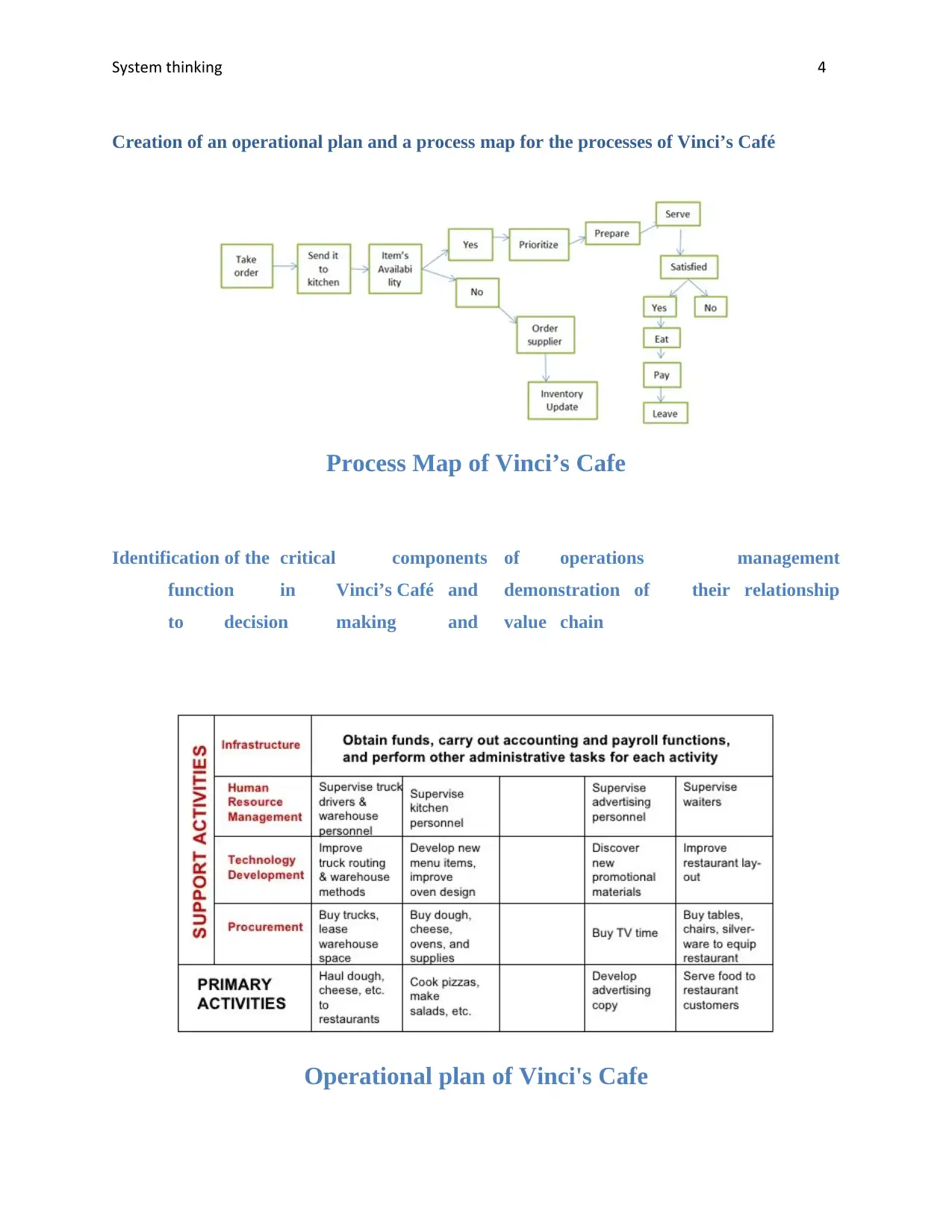
System thinking 4
Creation of an operational plan and a process map for the processes of Vinci’s Café
Process Map of Vinci’s Cafe
Identification of the critical components of operations management
function in Vinci’s Café and demonstration of their relationship
to decision making and value chain
Operational plan of Vinci's Cafe
Creation of an operational plan and a process map for the processes of Vinci’s Café
Process Map of Vinci’s Cafe
Identification of the critical components of operations management
function in Vinci’s Café and demonstration of their relationship
to decision making and value chain
Operational plan of Vinci's Cafe
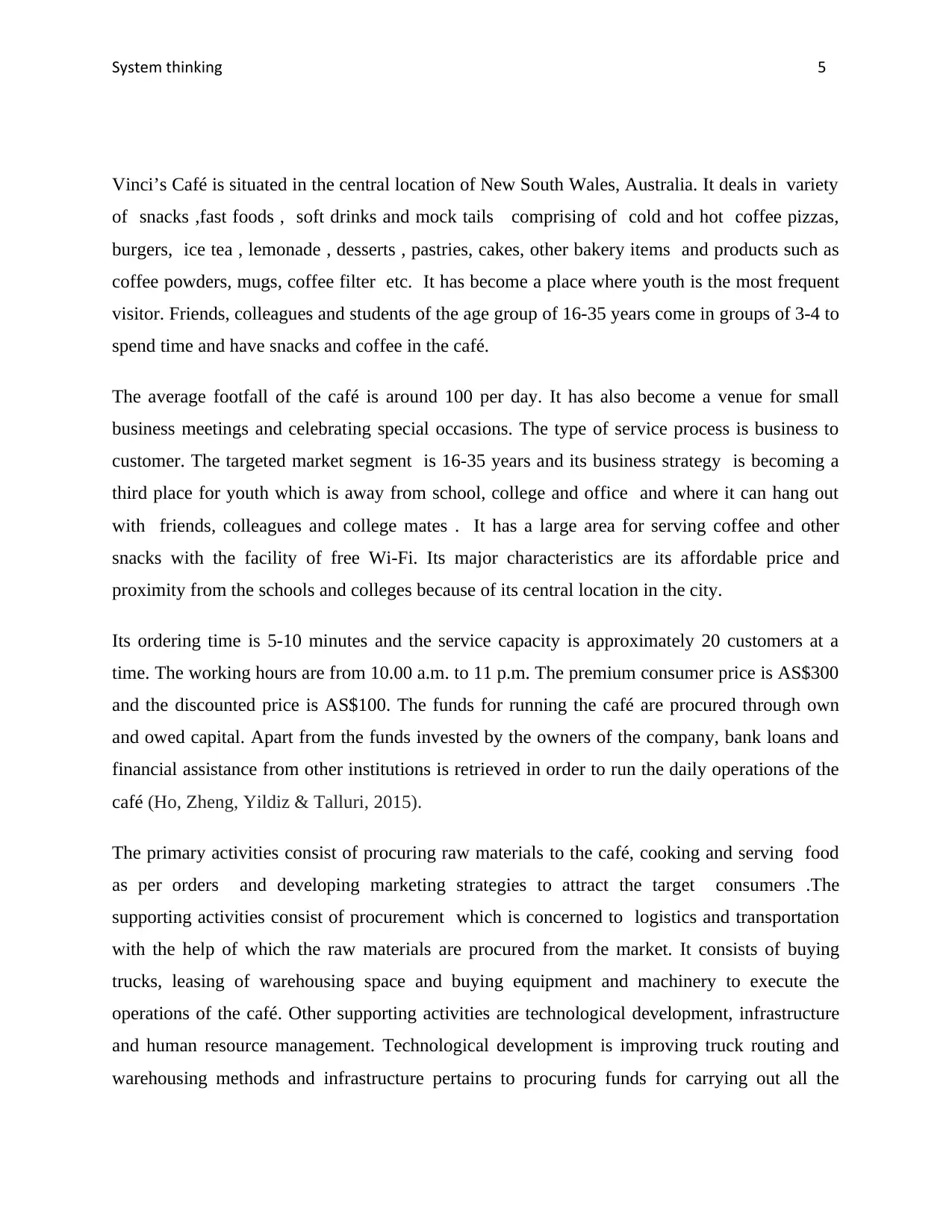
System thinking 5
Vinci’s Café is situated in the central location of New South Wales, Australia. It deals in variety
of snacks ,fast foods , soft drinks and mock tails comprising of cold and hot coffee pizzas,
burgers, ice tea , lemonade , desserts , pastries, cakes, other bakery items and products such as
coffee powders, mugs, coffee filter etc. It has become a place where youth is the most frequent
visitor. Friends, colleagues and students of the age group of 16-35 years come in groups of 3-4 to
spend time and have snacks and coffee in the café.
The average footfall of the café is around 100 per day. It has also become a venue for small
business meetings and celebrating special occasions. The type of service process is business to
customer. The targeted market segment is 16-35 years and its business strategy is becoming a
third place for youth which is away from school, college and office and where it can hang out
with friends, colleagues and college mates . It has a large area for serving coffee and other
snacks with the facility of free Wi-Fi. Its major characteristics are its affordable price and
proximity from the schools and colleges because of its central location in the city.
Its ordering time is 5-10 minutes and the service capacity is approximately 20 customers at a
time. The working hours are from 10.00 a.m. to 11 p.m. The premium consumer price is AS$300
and the discounted price is AS$100. The funds for running the café are procured through own
and owed capital. Apart from the funds invested by the owners of the company, bank loans and
financial assistance from other institutions is retrieved in order to run the daily operations of the
café (Ho, Zheng, Yildiz & Talluri, 2015).
The primary activities consist of procuring raw materials to the café, cooking and serving food
as per orders and developing marketing strategies to attract the target consumers .The
supporting activities consist of procurement which is concerned to logistics and transportation
with the help of which the raw materials are procured from the market. It consists of buying
trucks, leasing of warehousing space and buying equipment and machinery to execute the
operations of the café. Other supporting activities are technological development, infrastructure
and human resource management. Technological development is improving truck routing and
warehousing methods and infrastructure pertains to procuring funds for carrying out all the
Vinci’s Café is situated in the central location of New South Wales, Australia. It deals in variety
of snacks ,fast foods , soft drinks and mock tails comprising of cold and hot coffee pizzas,
burgers, ice tea , lemonade , desserts , pastries, cakes, other bakery items and products such as
coffee powders, mugs, coffee filter etc. It has become a place where youth is the most frequent
visitor. Friends, colleagues and students of the age group of 16-35 years come in groups of 3-4 to
spend time and have snacks and coffee in the café.
The average footfall of the café is around 100 per day. It has also become a venue for small
business meetings and celebrating special occasions. The type of service process is business to
customer. The targeted market segment is 16-35 years and its business strategy is becoming a
third place for youth which is away from school, college and office and where it can hang out
with friends, colleagues and college mates . It has a large area for serving coffee and other
snacks with the facility of free Wi-Fi. Its major characteristics are its affordable price and
proximity from the schools and colleges because of its central location in the city.
Its ordering time is 5-10 minutes and the service capacity is approximately 20 customers at a
time. The working hours are from 10.00 a.m. to 11 p.m. The premium consumer price is AS$300
and the discounted price is AS$100. The funds for running the café are procured through own
and owed capital. Apart from the funds invested by the owners of the company, bank loans and
financial assistance from other institutions is retrieved in order to run the daily operations of the
café (Ho, Zheng, Yildiz & Talluri, 2015).
The primary activities consist of procuring raw materials to the café, cooking and serving food
as per orders and developing marketing strategies to attract the target consumers .The
supporting activities consist of procurement which is concerned to logistics and transportation
with the help of which the raw materials are procured from the market. It consists of buying
trucks, leasing of warehousing space and buying equipment and machinery to execute the
operations of the café. Other supporting activities are technological development, infrastructure
and human resource management. Technological development is improving truck routing and
warehousing methods and infrastructure pertains to procuring funds for carrying out all the
⊘ This is a preview!⊘
Do you want full access?
Subscribe today to unlock all pages.

Trusted by 1+ million students worldwide
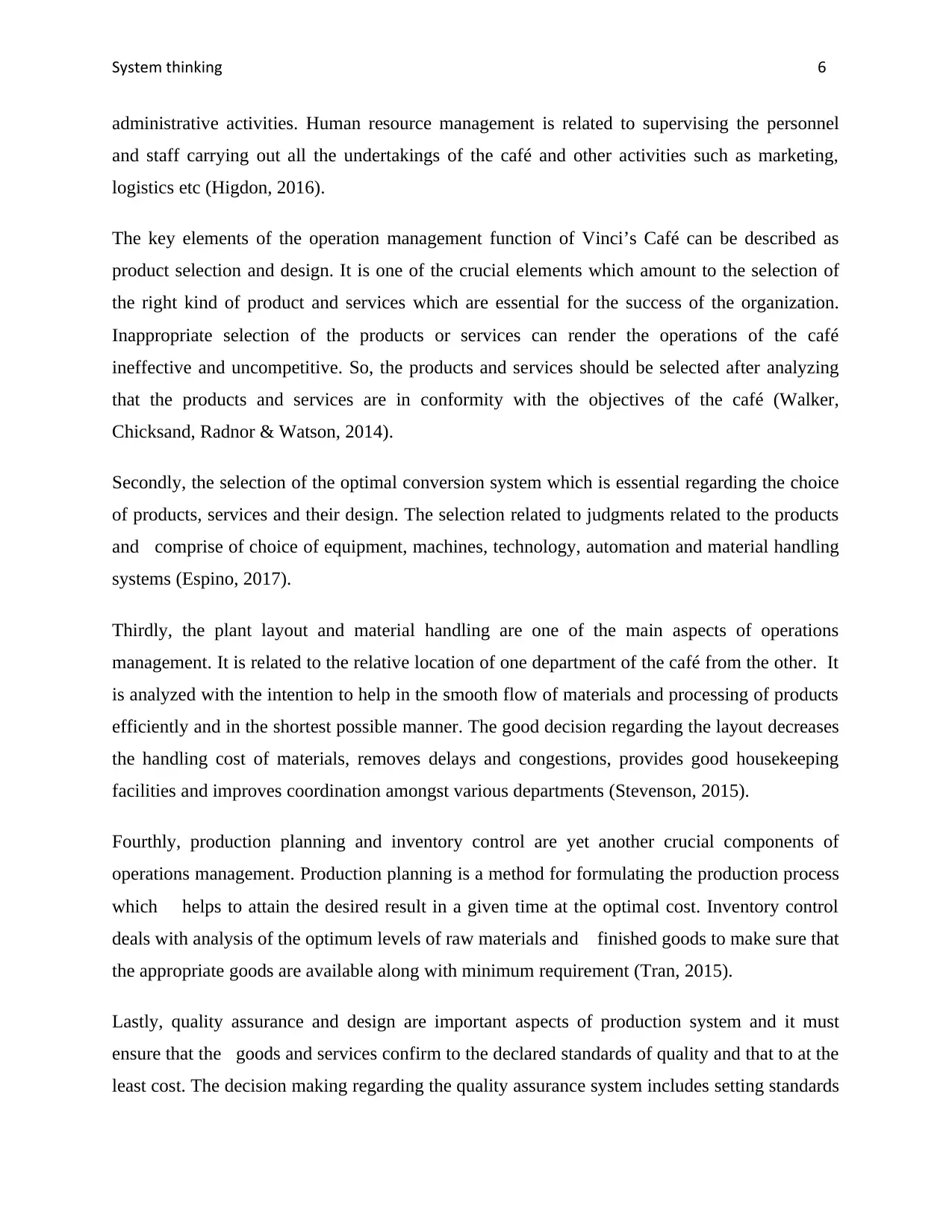
System thinking 6
administrative activities. Human resource management is related to supervising the personnel
and staff carrying out all the undertakings of the café and other activities such as marketing,
logistics etc (Higdon, 2016).
The key elements of the operation management function of Vinci’s Café can be described as
product selection and design. It is one of the crucial elements which amount to the selection of
the right kind of product and services which are essential for the success of the organization.
Inappropriate selection of the products or services can render the operations of the café
ineffective and uncompetitive. So, the products and services should be selected after analyzing
that the products and services are in conformity with the objectives of the café (Walker,
Chicksand, Radnor & Watson, 2014).
Secondly, the selection of the optimal conversion system which is essential regarding the choice
of products, services and their design. The selection related to judgments related to the products
and comprise of choice of equipment, machines, technology, automation and material handling
systems (Espino, 2017).
Thirdly, the plant layout and material handling are one of the main aspects of operations
management. It is related to the relative location of one department of the café from the other. It
is analyzed with the intention to help in the smooth flow of materials and processing of products
efficiently and in the shortest possible manner. The good decision regarding the layout decreases
the handling cost of materials, removes delays and congestions, provides good housekeeping
facilities and improves coordination amongst various departments (Stevenson, 2015).
Fourthly, production planning and inventory control are yet another crucial components of
operations management. Production planning is a method for formulating the production process
which helps to attain the desired result in a given time at the optimal cost. Inventory control
deals with analysis of the optimum levels of raw materials and finished goods to make sure that
the appropriate goods are available along with minimum requirement (Tran, 2015).
Lastly, quality assurance and design are important aspects of production system and it must
ensure that the goods and services confirm to the declared standards of quality and that to at the
least cost. The decision making regarding the quality assurance system includes setting standards
administrative activities. Human resource management is related to supervising the personnel
and staff carrying out all the undertakings of the café and other activities such as marketing,
logistics etc (Higdon, 2016).
The key elements of the operation management function of Vinci’s Café can be described as
product selection and design. It is one of the crucial elements which amount to the selection of
the right kind of product and services which are essential for the success of the organization.
Inappropriate selection of the products or services can render the operations of the café
ineffective and uncompetitive. So, the products and services should be selected after analyzing
that the products and services are in conformity with the objectives of the café (Walker,
Chicksand, Radnor & Watson, 2014).
Secondly, the selection of the optimal conversion system which is essential regarding the choice
of products, services and their design. The selection related to judgments related to the products
and comprise of choice of equipment, machines, technology, automation and material handling
systems (Espino, 2017).
Thirdly, the plant layout and material handling are one of the main aspects of operations
management. It is related to the relative location of one department of the café from the other. It
is analyzed with the intention to help in the smooth flow of materials and processing of products
efficiently and in the shortest possible manner. The good decision regarding the layout decreases
the handling cost of materials, removes delays and congestions, provides good housekeeping
facilities and improves coordination amongst various departments (Stevenson, 2015).
Fourthly, production planning and inventory control are yet another crucial components of
operations management. Production planning is a method for formulating the production process
which helps to attain the desired result in a given time at the optimal cost. Inventory control
deals with analysis of the optimum levels of raw materials and finished goods to make sure that
the appropriate goods are available along with minimum requirement (Tran, 2015).
Lastly, quality assurance and design are important aspects of production system and it must
ensure that the goods and services confirm to the declared standards of quality and that to at the
least cost. The decision making regarding the quality assurance system includes setting standards
Paraphrase This Document
Need a fresh take? Get an instant paraphrase of this document with our AI Paraphraser
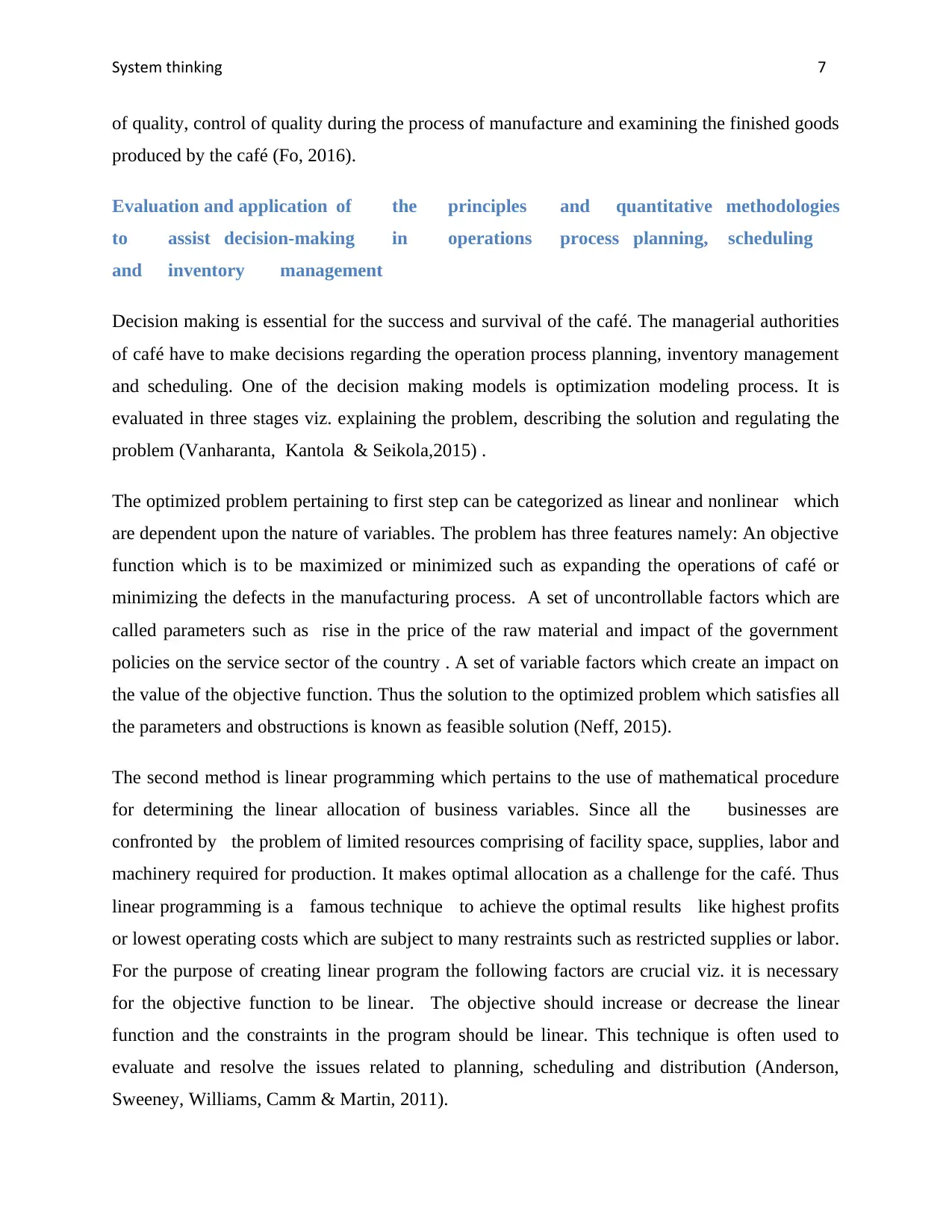
System thinking 7
of quality, control of quality during the process of manufacture and examining the finished goods
produced by the café (Fo, 2016).
Evaluation and application of the principles and quantitative methodologies
to assist decision-making in operations process planning, scheduling
and inventory management
Decision making is essential for the success and survival of the café. The managerial authorities
of café have to make decisions regarding the operation process planning, inventory management
and scheduling. One of the decision making models is optimization modeling process. It is
evaluated in three stages viz. explaining the problem, describing the solution and regulating the
problem (Vanharanta, Kantola & Seikola,2015) .
The optimized problem pertaining to first step can be categorized as linear and nonlinear which
are dependent upon the nature of variables. The problem has three features namely: An objective
function which is to be maximized or minimized such as expanding the operations of café or
minimizing the defects in the manufacturing process. A set of uncontrollable factors which are
called parameters such as rise in the price of the raw material and impact of the government
policies on the service sector of the country . A set of variable factors which create an impact on
the value of the objective function. Thus the solution to the optimized problem which satisfies all
the parameters and obstructions is known as feasible solution (Neff, 2015).
The second method is linear programming which pertains to the use of mathematical procedure
for determining the linear allocation of business variables. Since all the businesses are
confronted by the problem of limited resources comprising of facility space, supplies, labor and
machinery required for production. It makes optimal allocation as a challenge for the café. Thus
linear programming is a famous technique to achieve the optimal results like highest profits
or lowest operating costs which are subject to many restraints such as restricted supplies or labor.
For the purpose of creating linear program the following factors are crucial viz. it is necessary
for the objective function to be linear. The objective should increase or decrease the linear
function and the constraints in the program should be linear. This technique is often used to
evaluate and resolve the issues related to planning, scheduling and distribution (Anderson,
Sweeney, Williams, Camm & Martin, 2011).
of quality, control of quality during the process of manufacture and examining the finished goods
produced by the café (Fo, 2016).
Evaluation and application of the principles and quantitative methodologies
to assist decision-making in operations process planning, scheduling
and inventory management
Decision making is essential for the success and survival of the café. The managerial authorities
of café have to make decisions regarding the operation process planning, inventory management
and scheduling. One of the decision making models is optimization modeling process. It is
evaluated in three stages viz. explaining the problem, describing the solution and regulating the
problem (Vanharanta, Kantola & Seikola,2015) .
The optimized problem pertaining to first step can be categorized as linear and nonlinear which
are dependent upon the nature of variables. The problem has three features namely: An objective
function which is to be maximized or minimized such as expanding the operations of café or
minimizing the defects in the manufacturing process. A set of uncontrollable factors which are
called parameters such as rise in the price of the raw material and impact of the government
policies on the service sector of the country . A set of variable factors which create an impact on
the value of the objective function. Thus the solution to the optimized problem which satisfies all
the parameters and obstructions is known as feasible solution (Neff, 2015).
The second method is linear programming which pertains to the use of mathematical procedure
for determining the linear allocation of business variables. Since all the businesses are
confronted by the problem of limited resources comprising of facility space, supplies, labor and
machinery required for production. It makes optimal allocation as a challenge for the café. Thus
linear programming is a famous technique to achieve the optimal results like highest profits
or lowest operating costs which are subject to many restraints such as restricted supplies or labor.
For the purpose of creating linear program the following factors are crucial viz. it is necessary
for the objective function to be linear. The objective should increase or decrease the linear
function and the constraints in the program should be linear. This technique is often used to
evaluate and resolve the issues related to planning, scheduling and distribution (Anderson,
Sweeney, Williams, Camm & Martin, 2011).
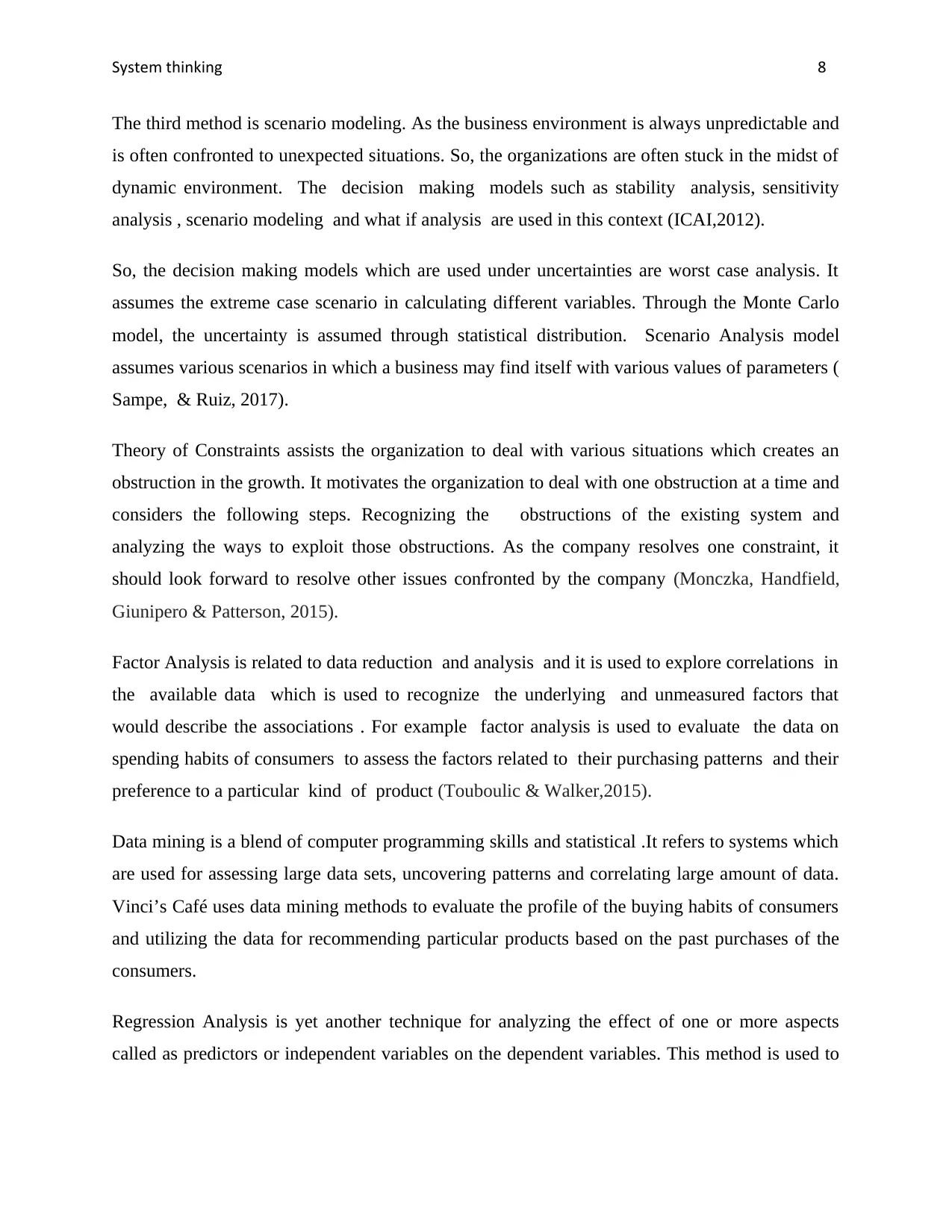
System thinking 8
The third method is scenario modeling. As the business environment is always unpredictable and
is often confronted to unexpected situations. So, the organizations are often stuck in the midst of
dynamic environment. The decision making models such as stability analysis, sensitivity
analysis , scenario modeling and what if analysis are used in this context (ICAI,2012).
So, the decision making models which are used under uncertainties are worst case analysis. It
assumes the extreme case scenario in calculating different variables. Through the Monte Carlo
model, the uncertainty is assumed through statistical distribution. Scenario Analysis model
assumes various scenarios in which a business may find itself with various values of parameters (
Sampe, & Ruiz, 2017).
Theory of Constraints assists the organization to deal with various situations which creates an
obstruction in the growth. It motivates the organization to deal with one obstruction at a time and
considers the following steps. Recognizing the obstructions of the existing system and
analyzing the ways to exploit those obstructions. As the company resolves one constraint, it
should look forward to resolve other issues confronted by the company (Monczka, Handfield,
Giunipero & Patterson, 2015).
Factor Analysis is related to data reduction and analysis and it is used to explore correlations in
the available data which is used to recognize the underlying and unmeasured factors that
would describe the associations . For example factor analysis is used to evaluate the data on
spending habits of consumers to assess the factors related to their purchasing patterns and their
preference to a particular kind of product (Touboulic & Walker,2015).
Data mining is a blend of computer programming skills and statistical .It refers to systems which
are used for assessing large data sets, uncovering patterns and correlating large amount of data.
Vinci’s Café uses data mining methods to evaluate the profile of the buying habits of consumers
and utilizing the data for recommending particular products based on the past purchases of the
consumers.
Regression Analysis is yet another technique for analyzing the effect of one or more aspects
called as predictors or independent variables on the dependent variables. This method is used to
The third method is scenario modeling. As the business environment is always unpredictable and
is often confronted to unexpected situations. So, the organizations are often stuck in the midst of
dynamic environment. The decision making models such as stability analysis, sensitivity
analysis , scenario modeling and what if analysis are used in this context (ICAI,2012).
So, the decision making models which are used under uncertainties are worst case analysis. It
assumes the extreme case scenario in calculating different variables. Through the Monte Carlo
model, the uncertainty is assumed through statistical distribution. Scenario Analysis model
assumes various scenarios in which a business may find itself with various values of parameters (
Sampe, & Ruiz, 2017).
Theory of Constraints assists the organization to deal with various situations which creates an
obstruction in the growth. It motivates the organization to deal with one obstruction at a time and
considers the following steps. Recognizing the obstructions of the existing system and
analyzing the ways to exploit those obstructions. As the company resolves one constraint, it
should look forward to resolve other issues confronted by the company (Monczka, Handfield,
Giunipero & Patterson, 2015).
Factor Analysis is related to data reduction and analysis and it is used to explore correlations in
the available data which is used to recognize the underlying and unmeasured factors that
would describe the associations . For example factor analysis is used to evaluate the data on
spending habits of consumers to assess the factors related to their purchasing patterns and their
preference to a particular kind of product (Touboulic & Walker,2015).
Data mining is a blend of computer programming skills and statistical .It refers to systems which
are used for assessing large data sets, uncovering patterns and correlating large amount of data.
Vinci’s Café uses data mining methods to evaluate the profile of the buying habits of consumers
and utilizing the data for recommending particular products based on the past purchases of the
consumers.
Regression Analysis is yet another technique for analyzing the effect of one or more aspects
called as predictors or independent variables on the dependent variables. This method is used to
⊘ This is a preview!⊘
Do you want full access?
Subscribe today to unlock all pages.

Trusted by 1+ million students worldwide
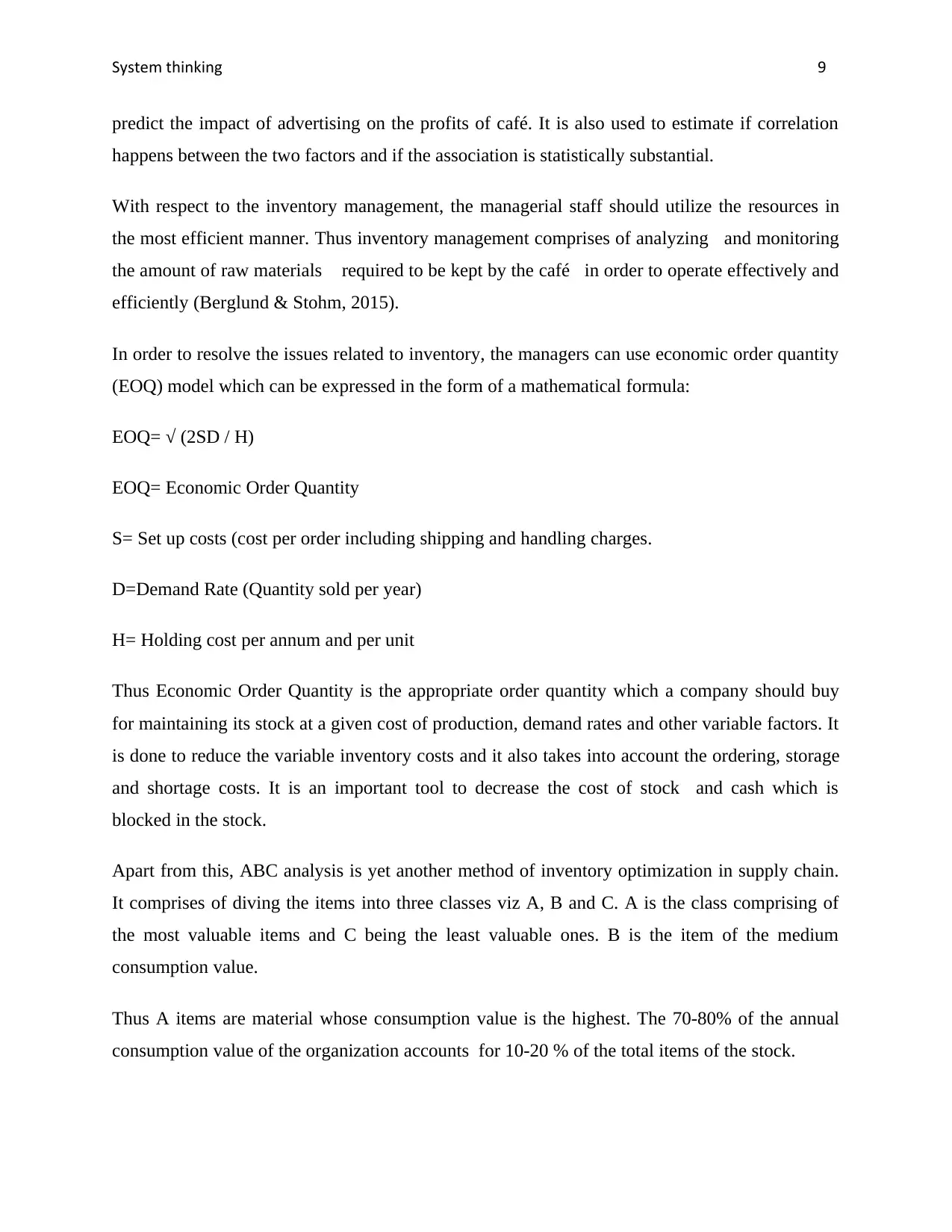
System thinking 9
predict the impact of advertising on the profits of café. It is also used to estimate if correlation
happens between the two factors and if the association is statistically substantial.
With respect to the inventory management, the managerial staff should utilize the resources in
the most efficient manner. Thus inventory management comprises of analyzing and monitoring
the amount of raw materials required to be kept by the café in order to operate effectively and
efficiently (Berglund & Stohm, 2015).
In order to resolve the issues related to inventory, the managers can use economic order quantity
(EOQ) model which can be expressed in the form of a mathematical formula:
EOQ= √ (2SD / H)
EOQ= Economic Order Quantity
S= Set up costs (cost per order including shipping and handling charges.
D=Demand Rate (Quantity sold per year)
H= Holding cost per annum and per unit
Thus Economic Order Quantity is the appropriate order quantity which a company should buy
for maintaining its stock at a given cost of production, demand rates and other variable factors. It
is done to reduce the variable inventory costs and it also takes into account the ordering, storage
and shortage costs. It is an important tool to decrease the cost of stock and cash which is
blocked in the stock.
Apart from this, ABC analysis is yet another method of inventory optimization in supply chain.
It comprises of diving the items into three classes viz A, B and C. A is the class comprising of
the most valuable items and C being the least valuable ones. B is the item of the medium
consumption value.
Thus A items are material whose consumption value is the highest. The 70-80% of the annual
consumption value of the organization accounts for 10-20 % of the total items of the stock.
predict the impact of advertising on the profits of café. It is also used to estimate if correlation
happens between the two factors and if the association is statistically substantial.
With respect to the inventory management, the managerial staff should utilize the resources in
the most efficient manner. Thus inventory management comprises of analyzing and monitoring
the amount of raw materials required to be kept by the café in order to operate effectively and
efficiently (Berglund & Stohm, 2015).
In order to resolve the issues related to inventory, the managers can use economic order quantity
(EOQ) model which can be expressed in the form of a mathematical formula:
EOQ= √ (2SD / H)
EOQ= Economic Order Quantity
S= Set up costs (cost per order including shipping and handling charges.
D=Demand Rate (Quantity sold per year)
H= Holding cost per annum and per unit
Thus Economic Order Quantity is the appropriate order quantity which a company should buy
for maintaining its stock at a given cost of production, demand rates and other variable factors. It
is done to reduce the variable inventory costs and it also takes into account the ordering, storage
and shortage costs. It is an important tool to decrease the cost of stock and cash which is
blocked in the stock.
Apart from this, ABC analysis is yet another method of inventory optimization in supply chain.
It comprises of diving the items into three classes viz A, B and C. A is the class comprising of
the most valuable items and C being the least valuable ones. B is the item of the medium
consumption value.
Thus A items are material whose consumption value is the highest. The 70-80% of the annual
consumption value of the organization accounts for 10-20 % of the total items of the stock.
Paraphrase This Document
Need a fresh take? Get an instant paraphrase of this document with our AI Paraphraser
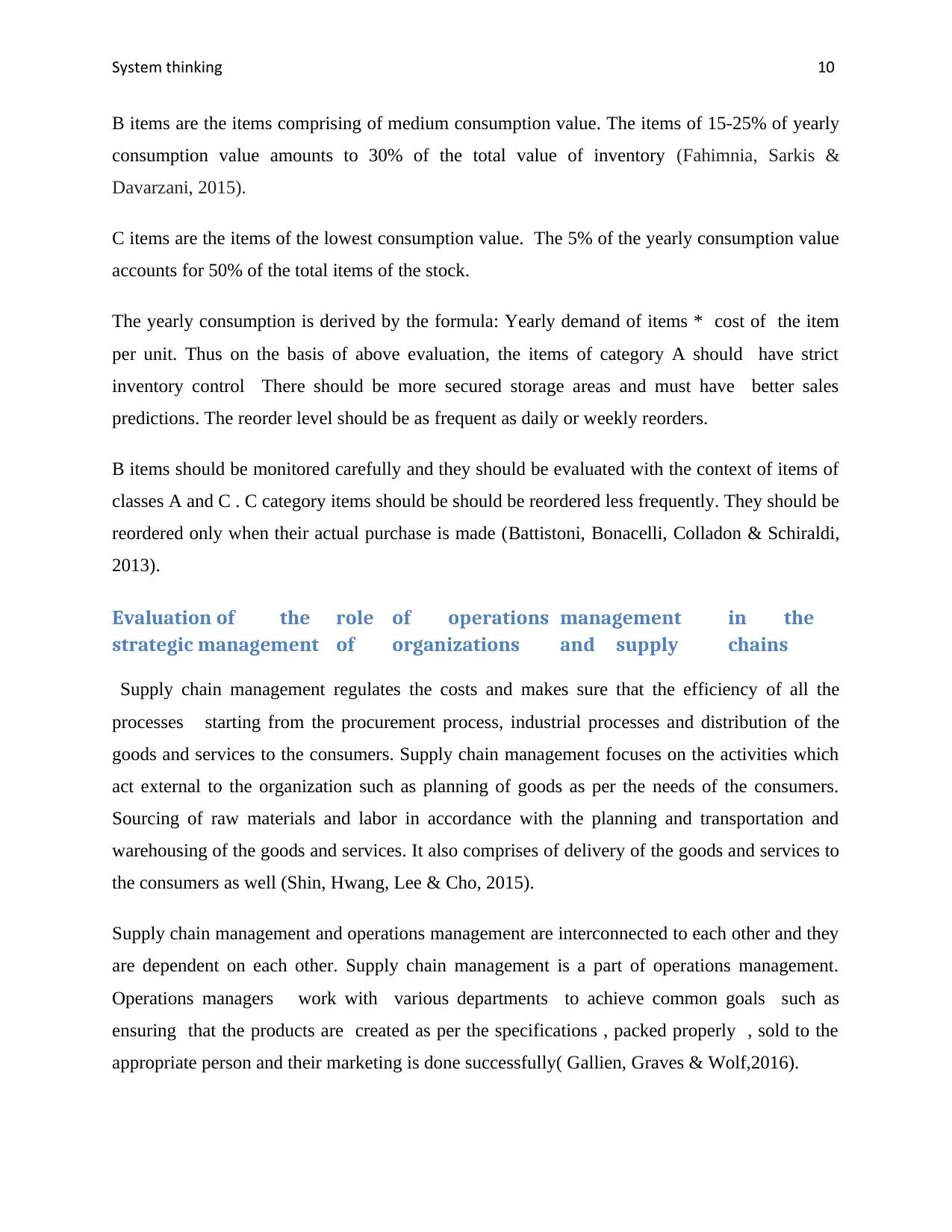
System thinking 10
B items are the items comprising of medium consumption value. The items of 15-25% of yearly
consumption value amounts to 30% of the total value of inventory (Fahimnia, Sarkis &
Davarzani, 2015).
C items are the items of the lowest consumption value. The 5% of the yearly consumption value
accounts for 50% of the total items of the stock.
The yearly consumption is derived by the formula: Yearly demand of items * cost of the item
per unit. Thus on the basis of above evaluation, the items of category A should have strict
inventory control There should be more secured storage areas and must have better sales
predictions. The reorder level should be as frequent as daily or weekly reorders.
B items should be monitored carefully and they should be evaluated with the context of items of
classes A and C . C category items should be should be reordered less frequently. They should be
reordered only when their actual purchase is made (Battistoni, Bonacelli, Colladon & Schiraldi,
2013).
Evaluation of the role of operations management in the
strategic management of organizations and supply chains
Supply chain management regulates the costs and makes sure that the efficiency of all the
processes starting from the procurement process, industrial processes and distribution of the
goods and services to the consumers. Supply chain management focuses on the activities which
act external to the organization such as planning of goods as per the needs of the consumers.
Sourcing of raw materials and labor in accordance with the planning and transportation and
warehousing of the goods and services. It also comprises of delivery of the goods and services to
the consumers as well (Shin, Hwang, Lee & Cho, 2015).
Supply chain management and operations management are interconnected to each other and they
are dependent on each other. Supply chain management is a part of operations management.
Operations managers work with various departments to achieve common goals such as
ensuring that the products are created as per the specifications , packed properly , sold to the
appropriate person and their marketing is done successfully( Gallien, Graves & Wolf,2016).
B items are the items comprising of medium consumption value. The items of 15-25% of yearly
consumption value amounts to 30% of the total value of inventory (Fahimnia, Sarkis &
Davarzani, 2015).
C items are the items of the lowest consumption value. The 5% of the yearly consumption value
accounts for 50% of the total items of the stock.
The yearly consumption is derived by the formula: Yearly demand of items * cost of the item
per unit. Thus on the basis of above evaluation, the items of category A should have strict
inventory control There should be more secured storage areas and must have better sales
predictions. The reorder level should be as frequent as daily or weekly reorders.
B items should be monitored carefully and they should be evaluated with the context of items of
classes A and C . C category items should be should be reordered less frequently. They should be
reordered only when their actual purchase is made (Battistoni, Bonacelli, Colladon & Schiraldi,
2013).
Evaluation of the role of operations management in the
strategic management of organizations and supply chains
Supply chain management regulates the costs and makes sure that the efficiency of all the
processes starting from the procurement process, industrial processes and distribution of the
goods and services to the consumers. Supply chain management focuses on the activities which
act external to the organization such as planning of goods as per the needs of the consumers.
Sourcing of raw materials and labor in accordance with the planning and transportation and
warehousing of the goods and services. It also comprises of delivery of the goods and services to
the consumers as well (Shin, Hwang, Lee & Cho, 2015).
Supply chain management and operations management are interconnected to each other and they
are dependent on each other. Supply chain management is a part of operations management.
Operations managers work with various departments to achieve common goals such as
ensuring that the products are created as per the specifications , packed properly , sold to the
appropriate person and their marketing is done successfully( Gallien, Graves & Wolf,2016).
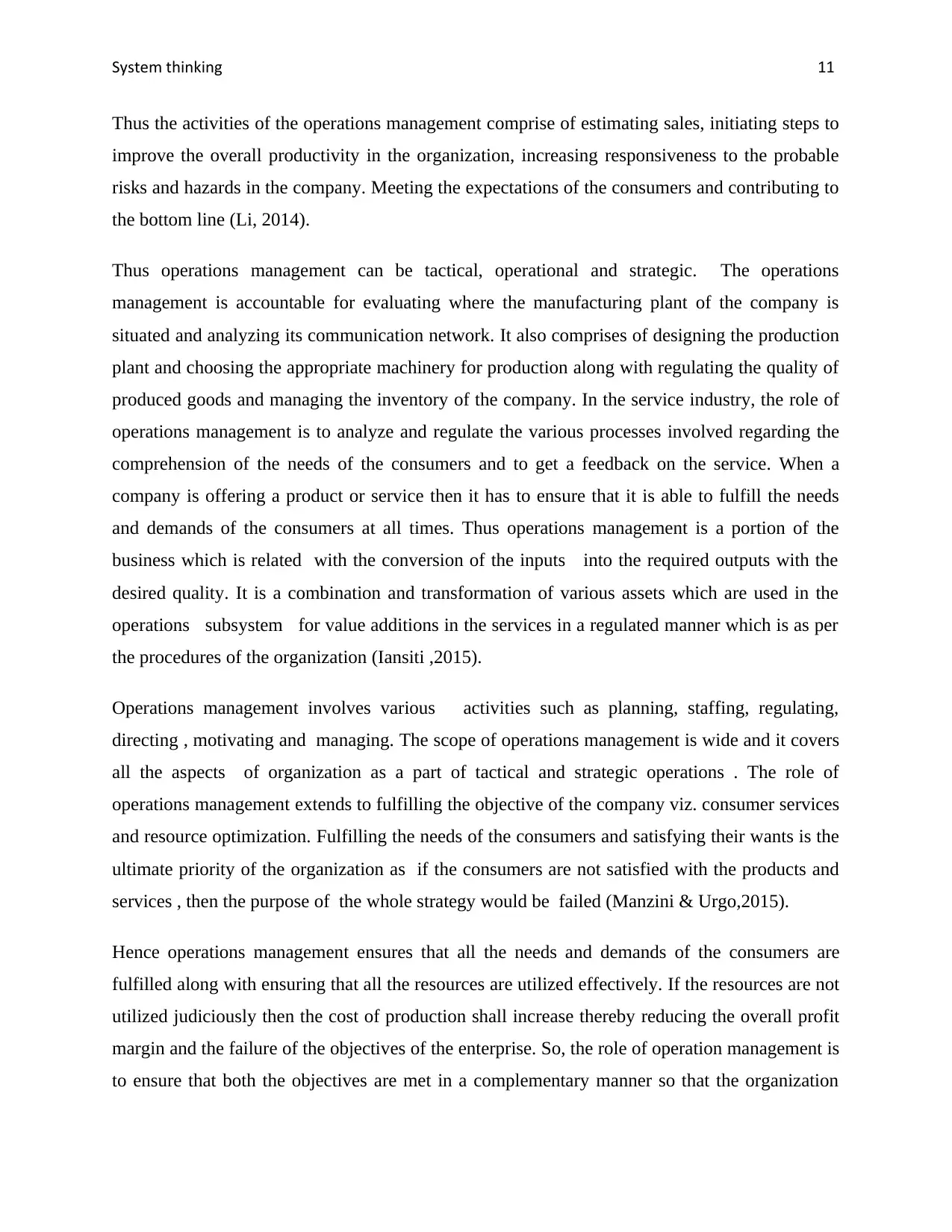
System thinking 11
Thus the activities of the operations management comprise of estimating sales, initiating steps to
improve the overall productivity in the organization, increasing responsiveness to the probable
risks and hazards in the company. Meeting the expectations of the consumers and contributing to
the bottom line (Li, 2014).
Thus operations management can be tactical, operational and strategic. The operations
management is accountable for evaluating where the manufacturing plant of the company is
situated and analyzing its communication network. It also comprises of designing the production
plant and choosing the appropriate machinery for production along with regulating the quality of
produced goods and managing the inventory of the company. In the service industry, the role of
operations management is to analyze and regulate the various processes involved regarding the
comprehension of the needs of the consumers and to get a feedback on the service. When a
company is offering a product or service then it has to ensure that it is able to fulfill the needs
and demands of the consumers at all times. Thus operations management is a portion of the
business which is related with the conversion of the inputs into the required outputs with the
desired quality. It is a combination and transformation of various assets which are used in the
operations subsystem for value additions in the services in a regulated manner which is as per
the procedures of the organization (Iansiti ,2015).
Operations management involves various activities such as planning, staffing, regulating,
directing , motivating and managing. The scope of operations management is wide and it covers
all the aspects of organization as a part of tactical and strategic operations . The role of
operations management extends to fulfilling the objective of the company viz. consumer services
and resource optimization. Fulfilling the needs of the consumers and satisfying their wants is the
ultimate priority of the organization as if the consumers are not satisfied with the products and
services , then the purpose of the whole strategy would be failed (Manzini & Urgo,2015).
Hence operations management ensures that all the needs and demands of the consumers are
fulfilled along with ensuring that all the resources are utilized effectively. If the resources are not
utilized judiciously then the cost of production shall increase thereby reducing the overall profit
margin and the failure of the objectives of the enterprise. So, the role of operation management is
to ensure that both the objectives are met in a complementary manner so that the organization
Thus the activities of the operations management comprise of estimating sales, initiating steps to
improve the overall productivity in the organization, increasing responsiveness to the probable
risks and hazards in the company. Meeting the expectations of the consumers and contributing to
the bottom line (Li, 2014).
Thus operations management can be tactical, operational and strategic. The operations
management is accountable for evaluating where the manufacturing plant of the company is
situated and analyzing its communication network. It also comprises of designing the production
plant and choosing the appropriate machinery for production along with regulating the quality of
produced goods and managing the inventory of the company. In the service industry, the role of
operations management is to analyze and regulate the various processes involved regarding the
comprehension of the needs of the consumers and to get a feedback on the service. When a
company is offering a product or service then it has to ensure that it is able to fulfill the needs
and demands of the consumers at all times. Thus operations management is a portion of the
business which is related with the conversion of the inputs into the required outputs with the
desired quality. It is a combination and transformation of various assets which are used in the
operations subsystem for value additions in the services in a regulated manner which is as per
the procedures of the organization (Iansiti ,2015).
Operations management involves various activities such as planning, staffing, regulating,
directing , motivating and managing. The scope of operations management is wide and it covers
all the aspects of organization as a part of tactical and strategic operations . The role of
operations management extends to fulfilling the objective of the company viz. consumer services
and resource optimization. Fulfilling the needs of the consumers and satisfying their wants is the
ultimate priority of the organization as if the consumers are not satisfied with the products and
services , then the purpose of the whole strategy would be failed (Manzini & Urgo,2015).
Hence operations management ensures that all the needs and demands of the consumers are
fulfilled along with ensuring that all the resources are utilized effectively. If the resources are not
utilized judiciously then the cost of production shall increase thereby reducing the overall profit
margin and the failure of the objectives of the enterprise. So, the role of operation management is
to ensure that both the objectives are met in a complementary manner so that the organization
⊘ This is a preview!⊘
Do you want full access?
Subscribe today to unlock all pages.

Trusted by 1+ million students worldwide
1 out of 16
Related Documents
Your All-in-One AI-Powered Toolkit for Academic Success.
+13062052269
info@desklib.com
Available 24*7 on WhatsApp / Email
![[object Object]](/_next/static/media/star-bottom.7253800d.svg)
Unlock your academic potential
Copyright © 2020–2025 A2Z Services. All Rights Reserved. Developed and managed by ZUCOL.





